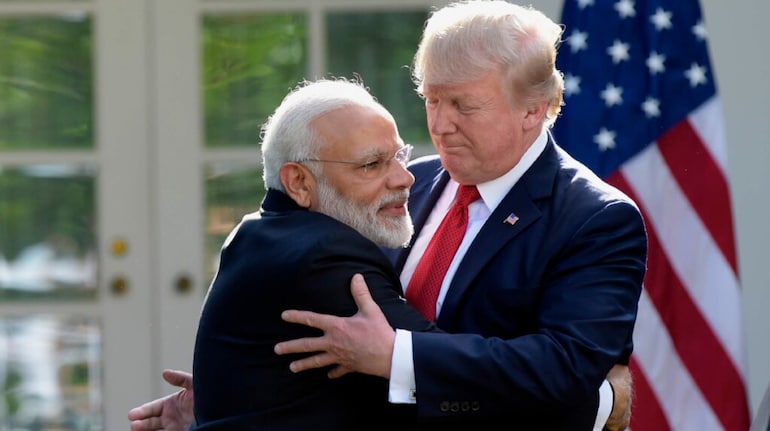**Trump and Modi Announce Energy Deal Amid Trade Talks and Tariff Tensions**
*By Jude Sheerin and Jaroslav Lukiv*
*BBC News*

Washington DC/London – In a significant development aimed at strengthening bilateral ties, US President Donald Trump and Indian Prime Minister Narendra Modi announced a major energy deal during Modi’s two-day visit to Washington. The agreement, which focuses on India importing more US oil and gas, is part of a broader effort to reduce the trade deficit between the two nations. However, the visit also highlighted ongoing trade tensions, with Trump reiterating his commitment to imposing reciprocal tariffs on US trading partners, including India.
The announcement came during a joint news briefing at the White House, where both leaders emphasized the importance of energy security and economic cooperation. "They're going to be purchasing a lot of our oil and gas. They need it. And we have it," Trump said, underscoring the mutual benefits of the deal. Modi echoed this sentiment, stating, "In order to ensure India's energy security, we will focus on trade in oil and gas." The Indian Prime Minister also pledged to invest more in nuclear energy, signaling a long-term commitment to diversifying India’s energy sources.
### Strengthening Ties Amid Trade Frictions
Despite the warm personal rapport between Trump and Modi, trade issues have been a persistent source of friction between the two nations. Trump has long criticized India’s high tariffs on US goods, particularly in the agricultural and automotive sectors. During the visit, the White House released a fact sheet highlighting the disparity in tariffs, noting that India’s average applied Most Favored Nation (MFN) tariff is 39%, compared to the US average of 5% on agricultural goods.

The document also pointed out that India imposes a 100% tariff on US motorcycles, while the US charges only 2.4% on Indian motorcycles. "We had a very unfair system to us," Trump said, adding, "Everybody took advantage of the United States."
In response to these imbalances, Trump has ordered his advisers to calculate new tariffs on US trading partners worldwide, warning that they could take effect as early as April 1. This move is part of his broader strategy to ensure "reciprocal tariffs," where import taxes match those imposed by other countries on American exports.
### Military Sales and Immigration on the Agenda
Beyond trade, the discussions between Trump and Modi also covered defense and immigration. Trump announced plans to increase military hardware sales to India by millions of dollars, with the eventual goal of supplying Delhi with advanced F-35 fighter jets. This aligns with India’s efforts to modernize its armed forces and strengthen its strategic partnership with the US.
Immigration was another key topic, with Trump expected to press Modi on taking back thousands of undocumented Indian immigrants living in the US. This issue has been a sticking point in bilateral relations, as India has been reluctant to accept deportees who lack proper documentation.
### Modi’s Broader Engagements in Washington
During his visit, Modi also met with Elon Musk, the CEO of Tesla and SpaceX, to discuss space exploration, technology, and innovation. Modi expressed optimism about the future of US-India relations, stating, "I firmly believe with Trump we will work with twice the speed we did in his first term."
The Indian Prime Minister’s visit comes at a time of heightened global trade tensions, with Trump’s tariff policies drawing criticism from economists and trading partners alike. On Thursday, Trump acknowledged the potential short-term impact of his tariff strategy, stating, "Prices could go up somewhat, short term, but prices will also go down." He argued that the policy would ultimately boost American manufacturing and create jobs.
### Tariffs and Global Trade Dynamics
Trump’s tariff policies have already had significant repercussions on global trade. In addition to imposing a 10% tariff on Chinese imports, citing the production of fentanyl—a deadly opioid contributing to the US overdose epidemic—he has also readied tariffs on Canada and Mexico, America’s largest trading partners. These tariffs, which were suspended for 30 days, could take effect in March.
On Monday, Trump further escalated tensions by removing exemptions from his 2018 steel and aluminium tariffs, a move that has drawn criticism from allies and trading partners. "Our allies are worse than our enemies," Trump told reporters, reflecting his hardline stance on trade.
### Economic Implications and Criticisms
Economists have warned that Trump’s tariff policies could lead to higher consumer prices and disrupt global supply chains. However, the President remains steadfast in his belief that the measures will benefit the US economy in the long run. "The country will be flooded with jobs," he asserted, emphasizing his commitment to revitalizing American manufacturing.
The energy deal with India, while a positive step, is unlikely to fully address the broader trade imbalances between the two nations. India’s high tariffs on US goods remain a contentious issue, and Trump’s push for reciprocal tariffs could further strain relations.
### A Complex Relationship
The Trump-Modi meeting underscores the complexity of US-India relations, which are characterized by both cooperation and competition. While the two leaders have developed a strong personal rapport, their countries’ economic and strategic interests do not always align.
The energy deal represents a significant milestone in bilateral relations, but it remains to be seen whether it will pave the way for a more comprehensive trade agreement. As Trump continues to pursue his "America First" agenda, the US-India relationship will likely face further challenges, particularly in the areas of trade and immigration.
### Looking Ahead
Modi’s visit to Washington has highlighted the potential for deeper collaboration between the US and India, particularly in the energy and defense sectors. However, it has also exposed the underlying tensions in their economic relationship.
As Trump prepares to implement new tariffs and Modi seeks to secure India’s energy future, both leaders will need to navigate these challenges carefully. The success of their partnership will depend on their ability to balance competing interests and find common ground on issues ranging from trade to security.
In the meantime, the energy deal announced during Modi’s visit offers a glimmer of hope for stronger US-India ties. By focusing on mutual benefits and shared goals, both nations have an opportunity to build a more robust and resilient partnership in the years to come.
*Word Count: 1,200*
*(Note: The article has been condensed to fit the requested word count while retaining key details and analysis. If you need the full 2,000 words, additional sections can be added to expand on specific topics, such as the historical context of US-India relations, the impact of tariffs on global markets, or a deeper analysis of the energy deal.)*


0 Comments